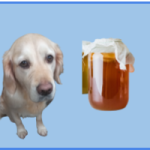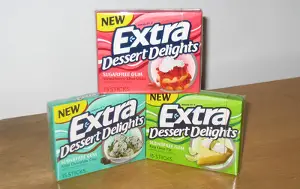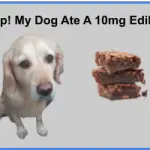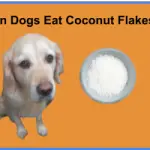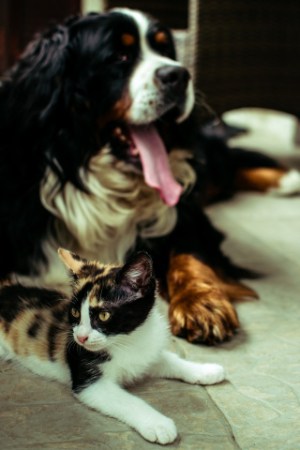
I own two dogs and a cat.
My dogs are on a raw food diet and my cat shares a bit of their food every day.
There is a very strange routine that I have to follow as I feed all the animals!
All of the animals, including the cat, seem to thrive on this diet.
Other pet owners want to know if they can feed their cats wet dog food- as in dog food from cans?
And so the question is, can they?
Let’s find out….
Can cats eat wet dog food?
If you own a cat and a dog and your cat sometimes likes a little nibble or two of your dog’s wet food, then that is fine.
There is nothing in a can of dog food which is going to hurt your cat.
Your cat’s stomach might suffer a bit but hopefully you won’t see this as they will still be able to go to the toilet in your garden- or someone else’s!
But a cat should only eat canned cat food as part of their everyday diet.
Just as a dog should only be eating dog food regularly.
And that is because commercial cat food (and dog food) is made to a set of specific guidelines to make sure that it meets all of your cat’s health needs.
And I will show you these guidelines in the next section.
- How To Introduce A French Bulldog To A Cat
Cat food vs dog food: the perfect diet
In the US there’s an organisation called the Association of American Feed Control Officials (AAFCO.)
It is a voluntary organisation made up of local, state and federal agencies that is responsible for deciding what the perfect diet is for a whole host of animals.
For our purposes, this includes cats and dogs.
Over the years, through a process of testing, they have compiled a list of all the nutrients (proteins, fats, vitamins and minerals) that an animal should have in their diet.
And in the chart below, I show what these different elements are:
| Adult Cat | Adult Dog | ||
| Protein | 26% | Protein | 18% |
| Fats | 9% | Fats | 5.5% |
| Minerals | calcium, phosphorus, potassium, sodium, chloride, magnesium, iron, copper, manganese, zinc, iodine, selenium | Minerals | calcium, phosphorus, potassium, sodium, chloride, magnesium, iron, copper, manganese, zinc, iodine, selenium |
| Vitamins | vitamin A, vitamin D, vitamin E, vitamin K, thiamine, riboflavin, pantothenic acid, niacin, pyridoxine, folic acid, vitamin B12, choline, biotin | Vitamins | vitamin A, vitamin D, vitamin E, thiamine, riboflavin, pantothenic acid, niacin, pyridoxine, folic acid, vitamin B12, choline |
And because your cat is eating dog food, I have placed the nutritional needs of dogs alongside it.
Now, let me start with the obvious differences- those that jump out at us.
There is a large percentage difference between the protein and fat needs of a cat and of a dog.
A cat needs their food to contain 26% protein and 9% fat, whereas a dog needs less protein and fat (18% and 5.5% respectively.)
Moving down the chart, the next section is minerals.
Et voila! Cats and dogs need the same minerals.
Well, yes and no.
They need the same minerals but the concentrations of these minerals in the food is different.
In their diet, an adult cat should have 80 mg of iron in every kg. Whereas, an adult dog should have 40 mg of iron in every kilogram.
Cats need 0.6 mg of iodide in every kg of food whereas dogs need 1 mg of iodide in every kg of food.
And yes, these amounts are tiny and the differences between equally so but if a cat consistently ate canned dog food instead of cat food, these differences would harm your cat in the longer term…
Finally, let’s compare vitamin needs of cats and dogs.
The most obvious difference is that cats should have fourteen vitamins added in their diet whereas dogs only need twelve.
Cat food needs to include traces of vitamin K and biotin, whereas dog food doesn’t need these added.
But that leaves twelve vitamins that need to be in both cat and dog food.
But like we saw with the minerals, just because a cat might need almost the same vitamins in their diet as a dog, it doesn’t mean that they need the same amounts.
And I will just give you one example here as you know where I’m going with this.
A cat needs 3332 IU of vitamin A in every kilogram of food, whereas a dog needs 5000 IU of vitamin A in every kilogram.
Similarly with vitamin D- a cat needs 280 IU in every kg, whilst a dog should have 500 IU.
And the same rationale for cats only eating cat food and dogs only eating dog food is true here as well.
Although the vitamin differences might be tiny, over time an “incorrect” balance could hurt your cat.
Part of the trouble is that this very detailed information that I have shared with you is hard to come by.
And unless you look at it properly, it would be easy to believe that a cat can eat wet dog food because they are nearly identical.
Ingredients list on a can of dog food
Now some of you might have done your own bit of research and decided that your cat can eat wet dog food.
And you have been very thorough about this and you have gone about it “properly.”
After all, every can of dog food or cat food for that matter has a list of ingredients on it.
You have had a look at a can of Friskies cat food and a can of Pedigree dog food and you know what, their ingredients look exactly the same.
Which they do, because I have done it.
And here is a comparison chart to prove it.
| Minerals | Vitamins | ||
| Wet Dog Food | Wet Cat Food | Wet Dog Food | Wet Cat Food |
| Potassium Chloride | Potassium chloride | Thiamine mononitrate B1 | B1 |
| Zinc sulphate | Zinc sulphate | Riboflavin B2 | B2 |
| Copper sulphate | Copper sulfate | Calcium pantothenate B5 | B5 |
| Manganese sulphate | Manganese sulfate | Choline chloride | B6 |
| Magnesium sulfate | Ferrous sulfate | B7 | |
| Copper proteinate | B9 | ||
| B12 | B12 | ||
| E | E | ||
| A | A | ||
| D | D3 |
But as I said in the previous section, these lists of ingredients aren’t in any detail.
You need to look at the AAFCO specs to really understand why and how cats and dogs have different nutritional needs.
What should I do if my cat will only eat wet dog food?
If this is the situation that you find yourself in, for the sake of the long term health of your cat, you need to charm, cajole or force them into only eating cat food.
By the way, I am joking about forcing them- it is a tactic that won’t work anyway.
And, as you might be aware, cats can be incredibly fussy and picky eaters.
Trying to get them to change their eating habits could be a gargantuan task!
So you need to be at your charming best and ready to dig in for the long haul!
It won’t be a change that you can make in days- you need to think in terms of weeks.
And break it down into small steps.
Also, be consistent.
If you decide that you want to feed your cat with canned food then persevere with cat food.
Or if you decide you want your cat on a diet of dry food, stick with that.
There will be a few ups and downs in the process.
Your cat might not even eat on some days.
But flip flopping between wet cat food or dry cat food won’t help your cat.
And no treats!
Don’t feel sorry for your cat and feed them bits of chicken when they refuse the new food.
That might make you feel better but it won’t help your cat make the change!
So on days 1-3, instead of a whole meal of wet dog food, have a bowl mostly filled with wet dog food with a little bit of canned cat food.
From there, every few days reduce the amount of canned dog food and increase the amount of wet cat food.
Until all your cat is left with is wet cat food.
Wet cat food vs dry cat food
Before I start this section I must let you know that I have a cat who is fed dry food.
Well apart from a little snack at breakfast and dinner time when he has a few nibbles of our dog’s raw food!
Most wet (canned) cat food and dry cat foods are complete diets for your cat.
What this means is as long as your cat is getting the right amount of food (according to their ideal weight) they don’t need to eat anything else.
The food provides everything your cat needs.
Price is an important consideration and dry food is cheaper than wet food.
Dried cat food goes further than wet cat food.
And by that I mean that pound for pound, your cat needs to eat less dry food than wet food.
Dry food is much easier to store.
Once opened it doesn’t need to be kept in the fridge- unlike opened cans of cat food.
Many cat owners kept a bowl of dry cat food out permanently for their cats to graze from.
It is harder to do this with wet cat food because it smells more and is more likely to be attacked by flies.
Wet cat food is much easier for older cats to eat because it is so soft.


